Gil Vicente are currently sat mid-table in the Portuguese Primeira Liga, yet are in a precarious position where one poor result could see them fall into relegation places. Set-pieces have been essential for them, summing up 23% of their goal total so far this season, helping them stay in a position of safety up until this point in the season.
They have primarily utilised one main corner routine, which has been interesting to analyse due to the multiple benefits players have from the movements made. While the routine is exciting, it has been mostly unsuccessful due to the difficulty of its execution, and so even though the ideas are promising and tactically make sense, the routine isn’t suitable for this side unless adaptations are made, which will be discussed later in the article.
In this tactical analysis, we will look into the tactics behind Gil Vicente’s attacking set-pieces, with an in-depth analysis of the critical details behind their primary corner method. This set-piece analysis will also look into the problems in executing that routine and some solutions that can be used to increase their efficiency in the future.
Primary Routine
Gil Vicente’s priority is to create chances through flick-ons to make the final actions as easy as possible for their players. The extra touch, between the corner being taken and before the ball is struck into the back of the net, is what makes this routine potentially incredible, but also the reason why so little success has come from it so far. The flick from the near side of the six-yard box, across the goal, is a potent tool that can unlock zonal defences, no matter how strong they are, while possessing the key to allow attackers to successfully dismark themselves from a defender.
Zonal defenders naturally have to react to the ball when a cross comes in, meaning they lose sight of potential attackers entering their areas. When a flick is made, the ball will usually fly past the six-yard box. If a defender cannot get goalside of the ball, they run the risk of deflecting it into the back of their own net, whilst being too deep in the goal may mean that they cannot step up and clear the ball in time. As a result, zonal defenders usually wait in the middle ground, where they only have a small amount of space they can compete for the ball in after a flick-on.
They can’t attack the ball with as much pace as an attacker, when there is so little time to react and adapt to the new trajectory of the ball, meaning that any attacker who arrives from deep will be able to use their momentum to reach the ball before their marker unless the defender can spot the attacker and disrupt their run, or unless the ball comes directly to the defender.
We can break the routine down into the two different roles the groups of attackers are responsible for attacking: the ‘Access Point’ and the ‘Scoring Territory’. Using runs from deep, in a parallel direction to the goal, takes an element of what makes Arsenal such a strong set-piece side in the Premier League, which largely increases the chance of making the first contact on the ball. However, Gil Vicente also use runs to the goal, from the edge of the penalty area, to maximise the chance of shots hitting the back of the net, with attackers able to attack the ball with the momentum that makes a potential strike unstoppable.
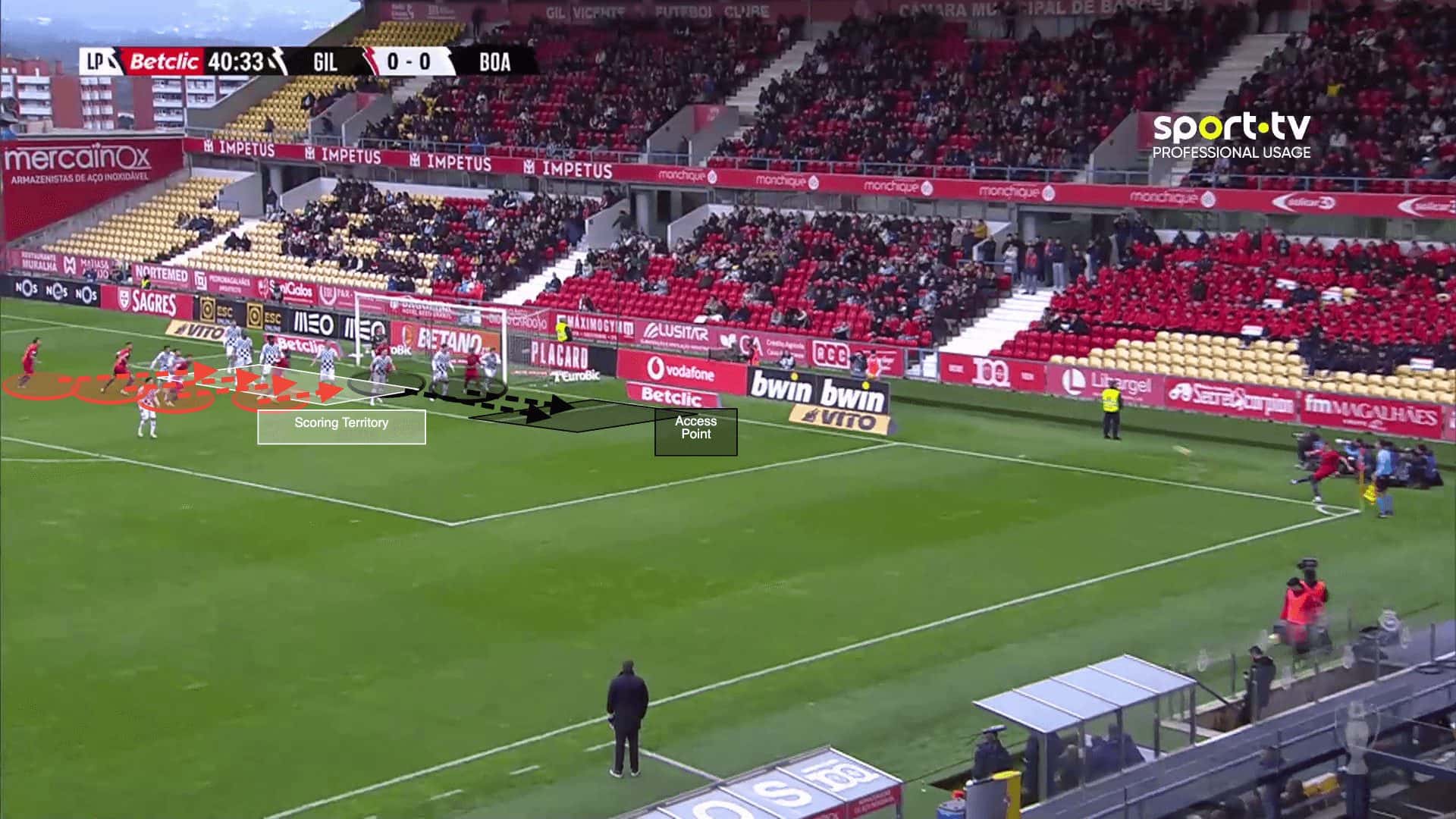
Arriving in the ‘Access Point’
As you will see in the majority of Gil Vicente’s corner kicks, players are always aiming to arrive in the area shown below to flick the ball over the first couple of zonal defenders so the ball can arrive in the ‘Scoring Territory’ as seen earlier in the article.
This is referred to as the ‘Access Point’ as it is a part of the box that is usually left vulnerable and exposed due to the limited probability of a shot being scored from such a tight angle. Most teams often leave this area less protected, so Gil Vicente can consistently attempt to exploit the space there. However, due to the low probability of a goal being scored from the ‘Access Point’, Gil Vicente only used this area to make the assist easier to achieve. It can be hard to cross the ball directly into the six-yard box, but due to the reasons mentioned earlier, the use of flicks makes it much easier to enter such a high-value area.
One of the most common and easiest ways to arrive at the ‘Access Point’ is through the deeper positioning by the goal, where players come in the zone from the defenders’ blindside. This is a tactic commonly used by Arsenal this season, where good timing of the run can mean that a player will arrive in that area as the ball does, giving the nearest defender no time to disrupt the player/attack the ball.
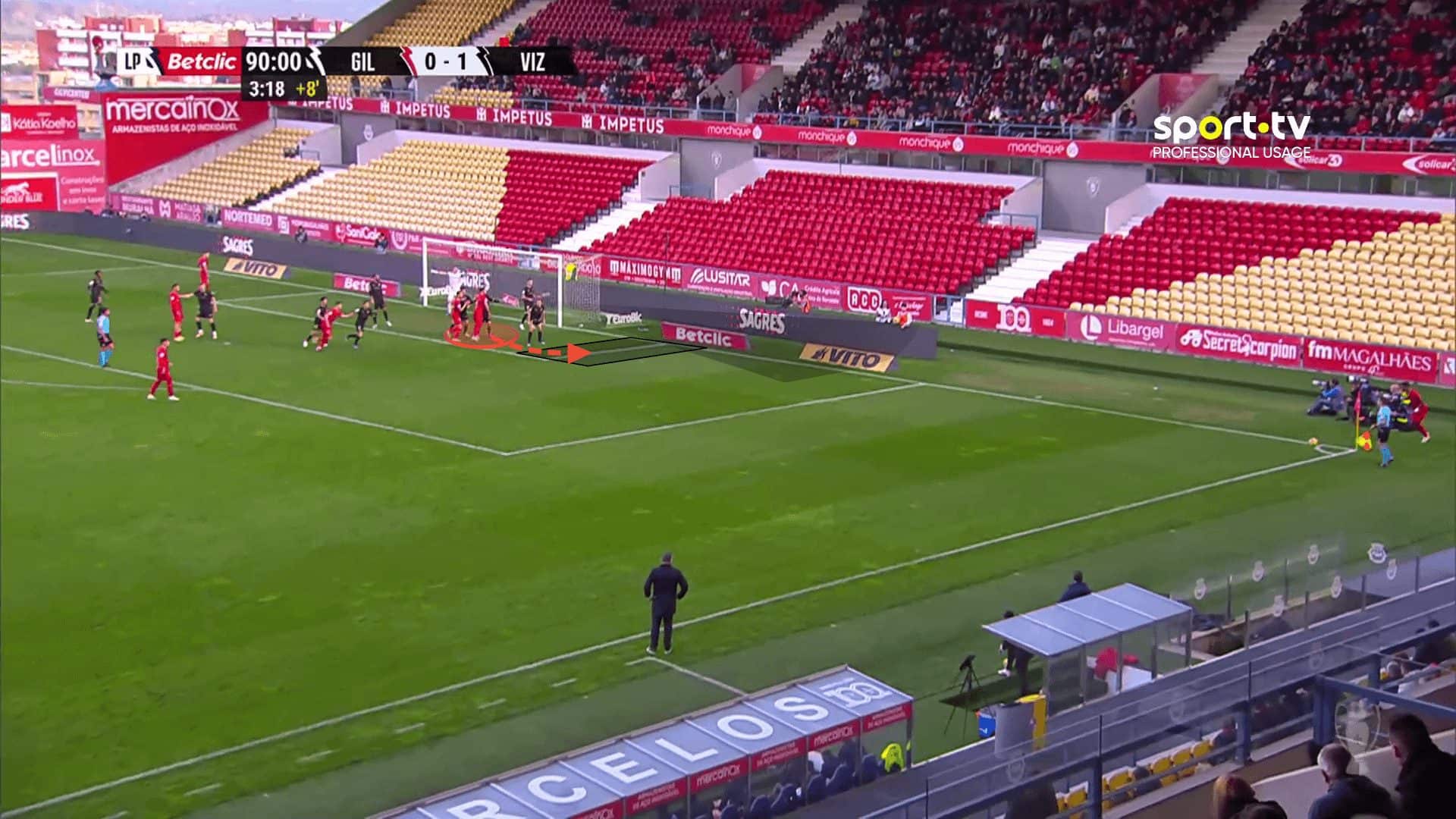
Another detail that Gil Vicente have used to make the player making the flick-on more likely to make the first contact, is to arrive in the target area from different angles. Approaching one area from various angles means that even if there is a zonal defender who is expecting an arrival and attempting to intercept the run, he cannot intercept two people at once, meaning that one player is guaranteed to arrive unopposed, granted that they’ve lost their initial marker through an excellent first movement.
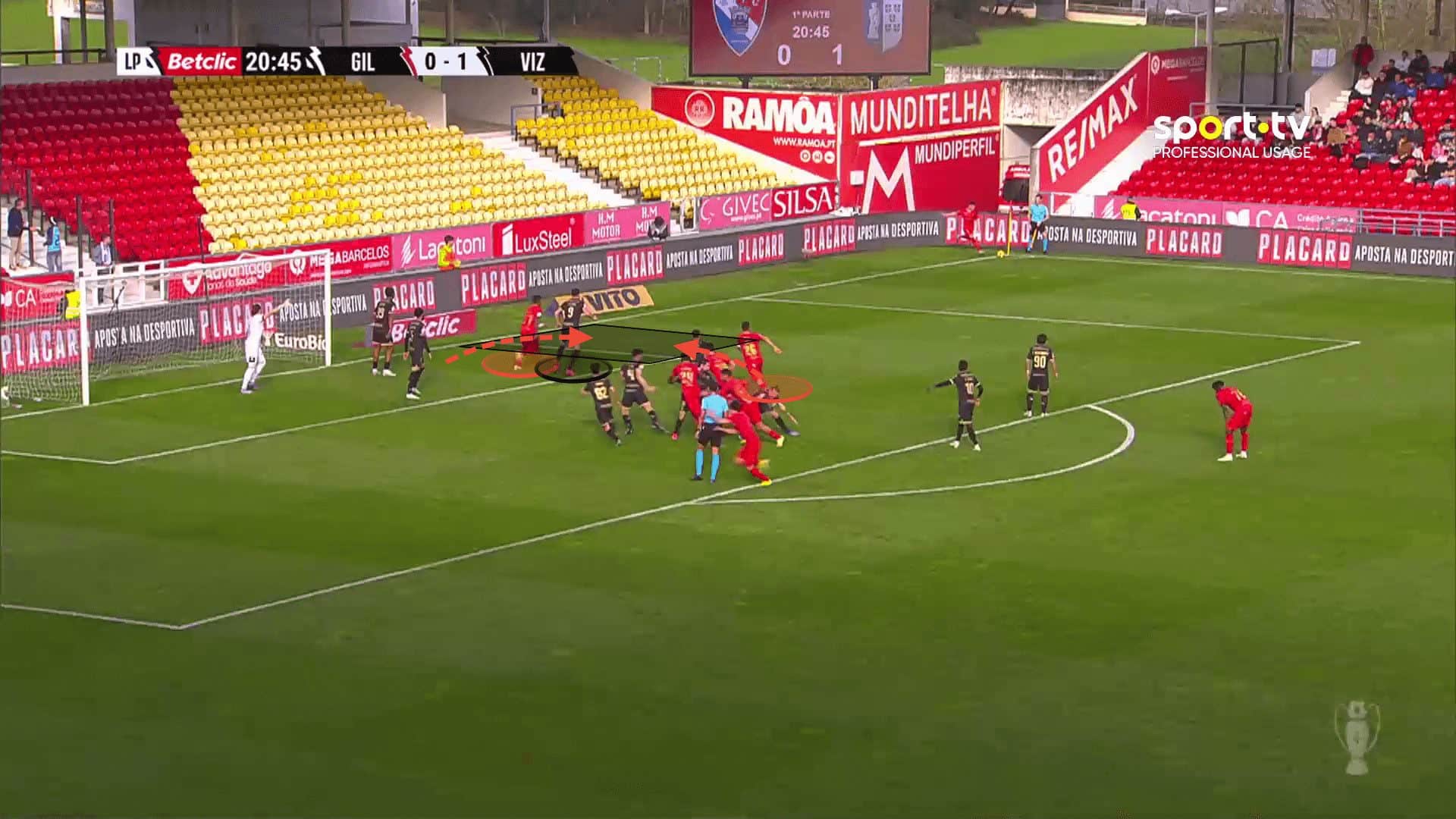
Entering the ‘Scoring Territory’
To arrive in the secondary zone labelled as the ‘Scoring Territory’ located just inside the six-yard box, attackers need to be able to arrive there without any markers being touch-tight. There are numerous ways to arrive in the six-yard box with separation, whilst the extra flick makes losing your marker even easier.
Gil Vicente mainly use runs from deep, where attackers try to remain at arm’s length from their markers. When a man marker can stay in contact with their player, they can intercept their runs, as they can feel the direction the attacker is moving in whilst still focusing on the ball. However, as soon as that distance increases, defenders cannot track both the direction of the run and the ball’s trajectory, giving attackers the separation needed to break into the six-yard box unopposed.
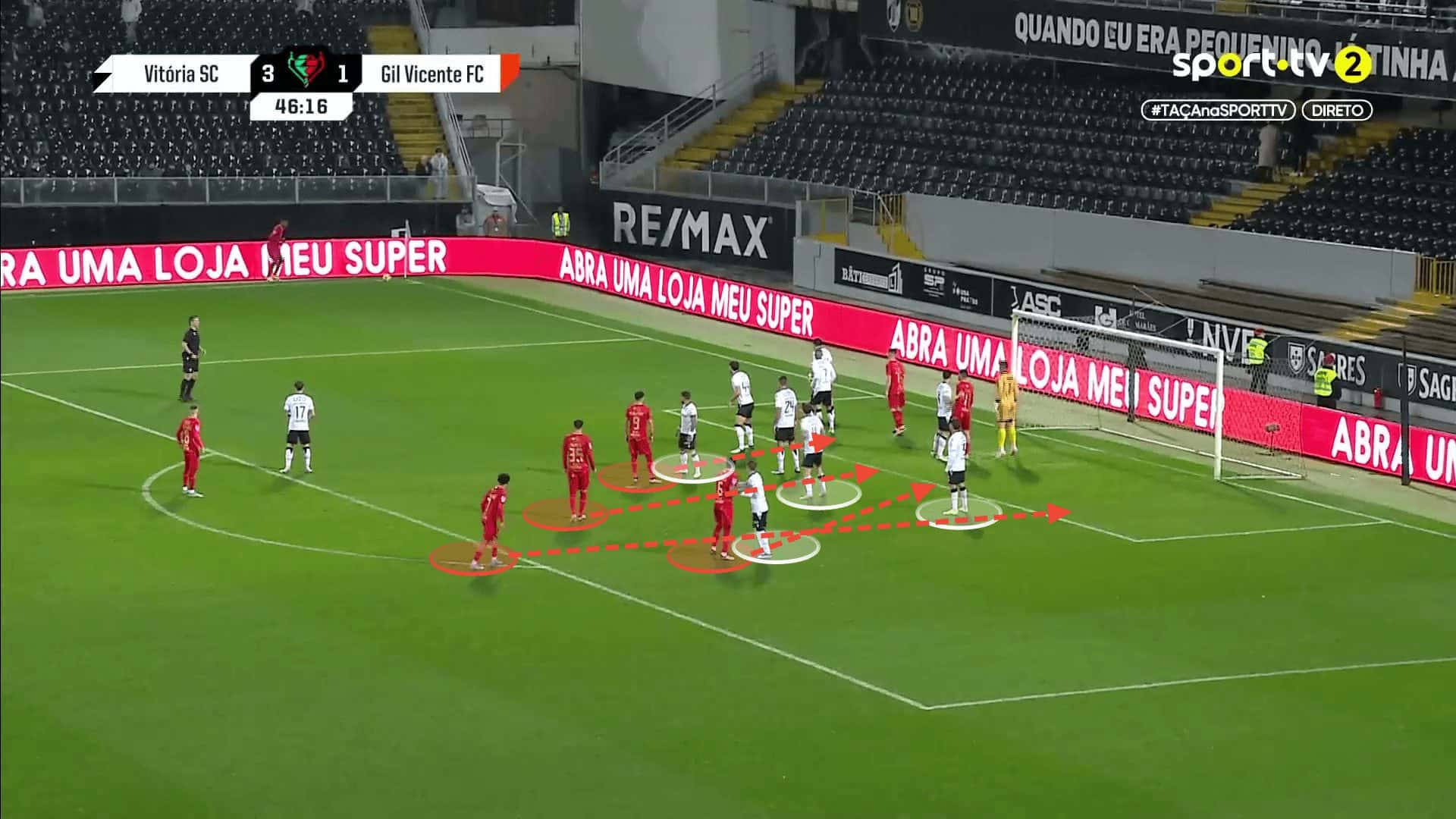
The benefit of a run from deep is that even if spare zonal defenders are waiting in and around the six-yard box, the momentum generated from a six-yard sprint can be strong enough to give the attacker enough power to outjump the static zonal defender. Furthermore, even if the corner kick is overhit and arrives in the ‘Scoring Territory’ instantly, attackers are arriving who have the advantage in those aerial duels, even though then the defenders would have extra time to attack the ball and cancel out that advantage generated through momentum.
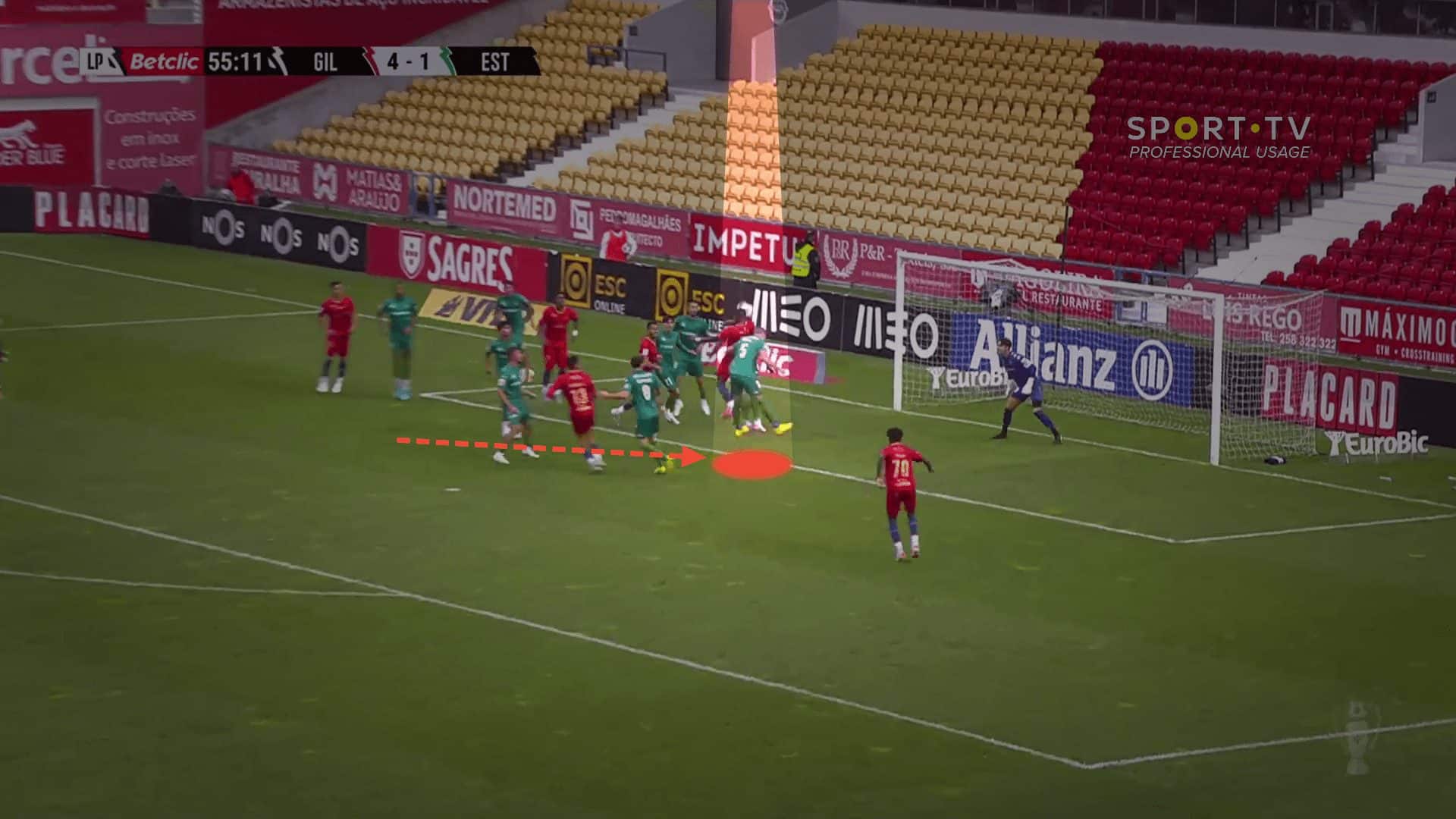
As discussed earlier, attackers who arrive from deep are able to lose their markers once the kick is taken as they begin to focus on the ball. Building on top of that, Gil Vicente take even more measures to ensure an attacker arrives unmarked by using an attacker from outside the box, who looks to be part of the rest defence. The defender has no reason to tightly mark someone outside the box waiting to collect a loose ball, which gives the attacker an easier way to ghost into the box and arrive at the back post without opposition.
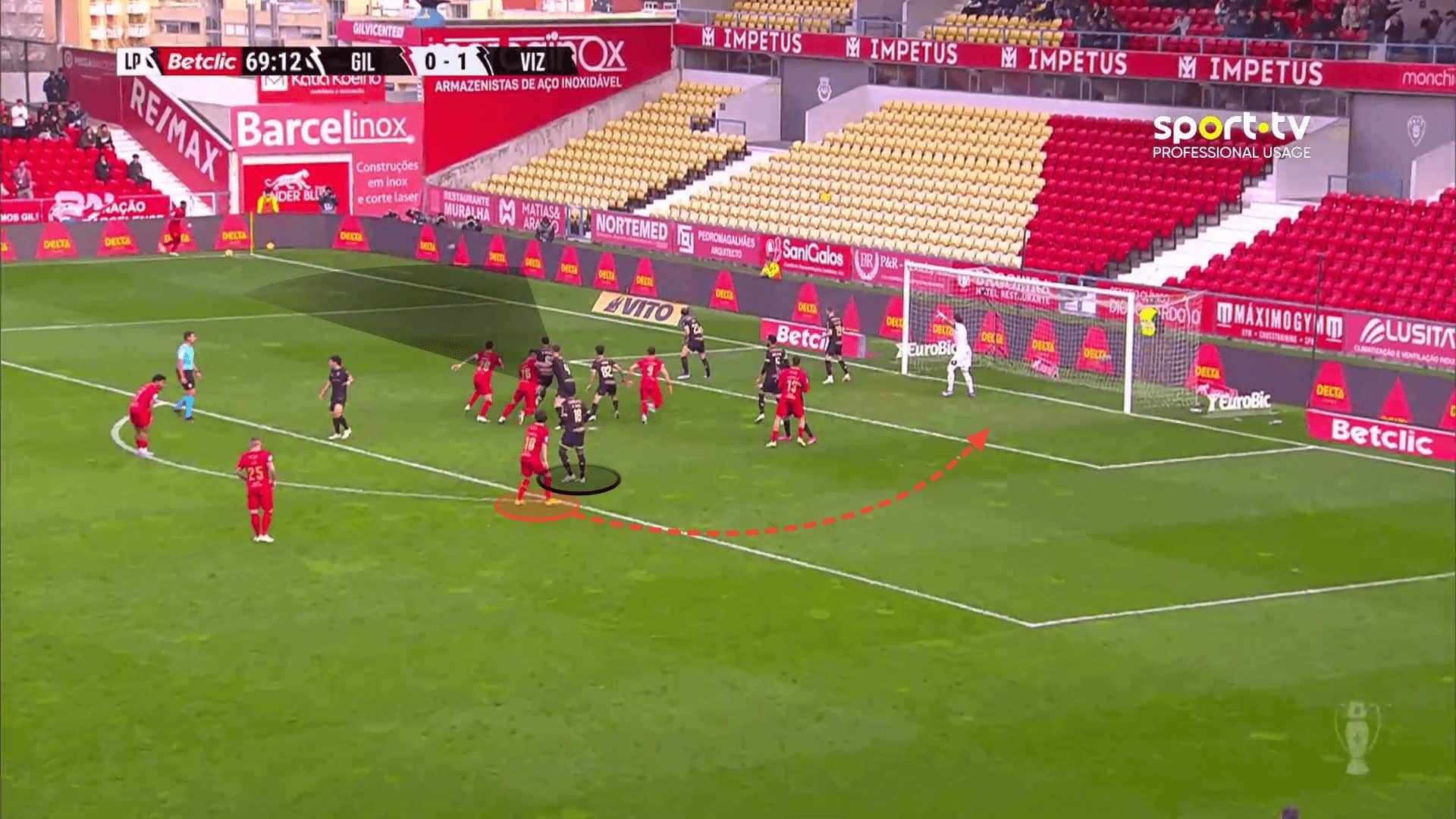
This is most particularly effective when there is no zonal marker at the back side of the six-yard box. Gil Vicente have scored from a corner kick this way once this season, where a run from outside the box arrives at the far side of the six-yard box, wholly unmarked and able to volley the ball into the back of the net, something seen recently used by Aston Villa.
One way in which it is possible to drag zonal defenders away from their specific zones is to purposefully allow them to get touch-tight, where they latch themselves to an attacker. That attacker can then move away from the zone, as seen in the example below, which means the zonal defender is dragged away, not realising a player from outside the box has made a run towards the goal.
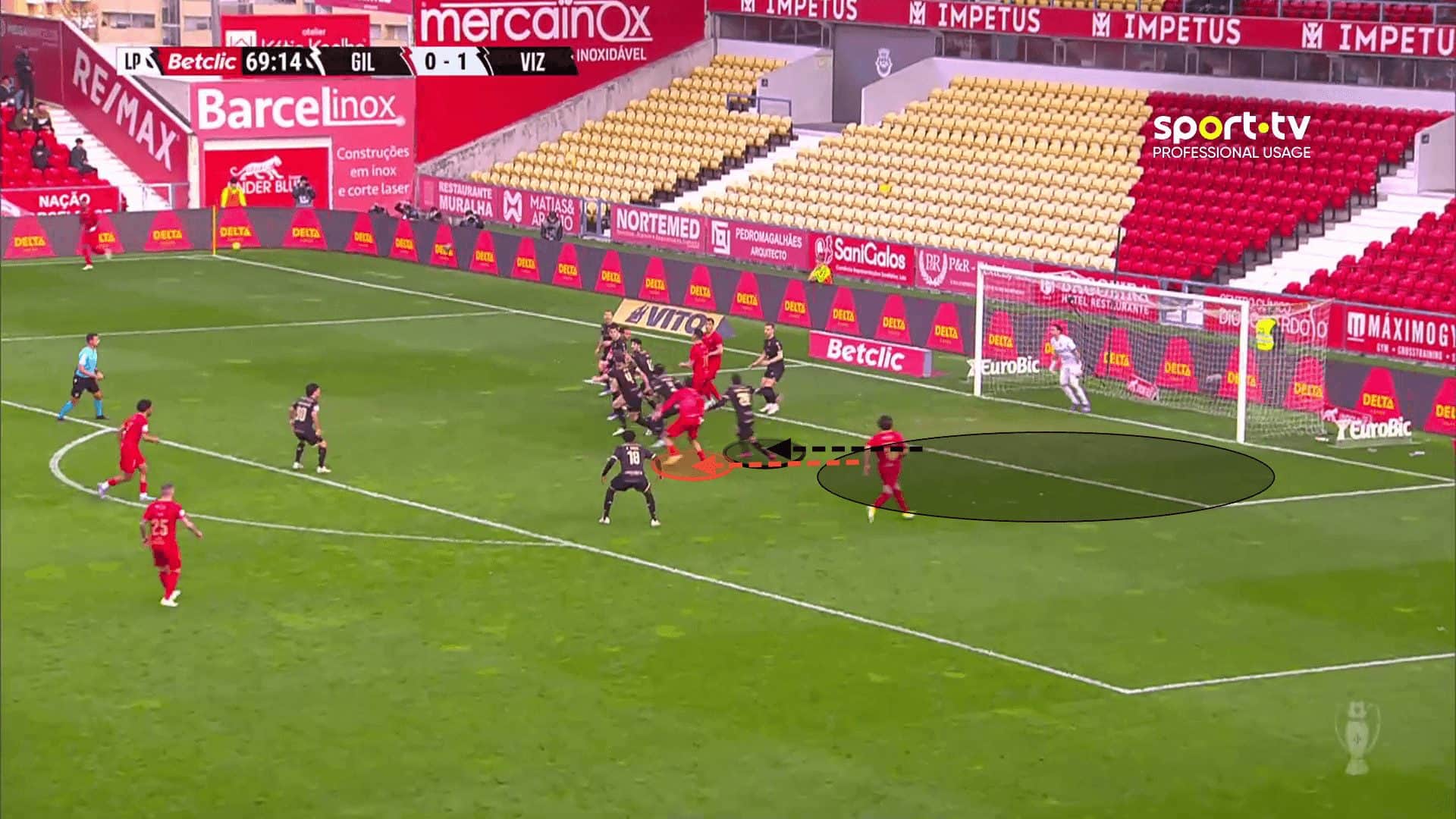
How Could The Routine Be Adapted?
While the analysis has described the multiple benefits of attacking the area on the near-side of the six-yard box before flicking it to other areas of the penalty area, the reality is that this move has not led to a goal for Gil Vicente once this season, due to several reasons.
The move has usually failed at the first hurdle, making the first contact in the ‘Access Point’. The corner must be played high enough so that a player can flick the ball on with their head, but if it is played too high, the ball reaches a zonal defender, with the attackers from deep still a step or two away from being in reach of the ball. It is difficult to play that flat delivery consistently, so Gil Vicente must adapt to the current circumstances.
One solution to the issue could be to increase the number of players arriving at the ‘Access Point’. The priority must be for the ball to be flicked on across the six-yard box, and for that to become a reality consistently, Gil Vicente could increase the number of players arriving at the near side of the six-yard box, meaning that those arriving cover more ground where the delivery could land in.
Having more targets in the ‘Access Point’ will increase the number of times the crucial first contact is made by 1) giving the cross more targets to find and 2) overloading zonal defenders in that area, meaning that some attackers will have no zonal defender competing for the ball. Once they are confident in making the ball travel across the six-yard box, only one player is required to make the final touch to redirect the ball into the goal, with this analysis having explained that the actual finish is the easier part of this routine and doesn’t need as many bodies attacking the ‘Scoring Territory’.
In the summer, they can always look for a specialist with the ability to deliver the required cross on command, but that cannot be fixed overnight.
The timing of the cross and runs also needs to be aligned. There have been many occasions this season where the cross was delivered excellently, but the run to the ‘Access Point’ was made either too early or too late, meaning that the attacker was unable to attack the ball unopposed consistently, as the defender was able to track the run and compete for the ball.
Summary
This tactical analysis has examined the multiple potential benefits of Gil Vicente’s corner routine, but the difficulty of execution has meant that, more often than not, they have been unable to make the first contact, making their routine wasteful.
Gil Vicente’s corners make the actual finish extremely likely to be successful, but attempting to enter the high-value areas like the six-yard box is incredibly difficult, meaning that getting shots off from corner kicks has been too rare of an occasion.
We have described some steps they could take to increase their efficiency with this corner kick routine, but if things continue as they have been, we can expect Gil Vicente to create high xG chances on very limited occasions, with the most common result being the cross being cleared by the first man.






Comments